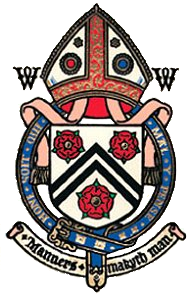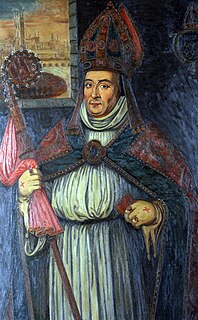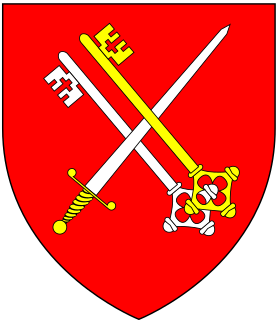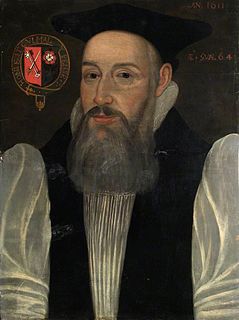
Winchester College is an independent boarding school for boys in the British public school tradition, situated in Winchester, Hampshire. It has existed in its present location for over 600 years. It is the oldest of the nine English public schools considered by the Clarendon Commission, seven of which were regulated by the Public Schools Act 1868.

Beeston is a town in Nottinghamshire, England, 3.4 miles (5.5 km) south-west of Nottingham city centre. To the immediate north-east is the University of Nottingham's main campus, University Park. The pharmaceutical and retail chemist group Boots has its headquarters 0.6 miles (1 km) east of the centre of Beeston, on the border with Broxtowe and the City of Nottingham. To the south lies the River Trent and the village of Attenborough, with its extensive wetlands.

William of Wykeham was Bishop of Winchester and Chancellor of England. He founded New College, Oxford, and New College School in 1379, and founded Winchester College in 1382. He was also the clerk of works when much of Windsor Castle was built.

Charles Paulet, 2nd Duke of Bolton was Lord Lieutenant of Ireland, Member of Parliament for Hampshire and a supporter of William III of Orange.

William Waynflete, born William Patten, was Provost of Eton (1442–1447), Bishop of Winchester (1447–1486) and Lord Chancellor of England (1456–1460). He is best remembered as the founder of Magdalen College and Magdalen College School in Oxford.

Arthur Lake was Bishop of Bath and Wells and a translator of the King James Version of The Bible.

The Very Reverend George William Kitchin, MA, DD, FSA was the first Chancellor of the University of Durham, from the institution of the role in 1908 until his death in 1912. He was also the last Dean of Durham to govern the university.

The Bishop of Winchester is the diocesan bishop of the Diocese of Winchester in the Church of England. The bishop's seat (cathedra) is at Winchester Cathedral in Hampshire. The Bishop of Winchester holds ex officio the office of Prelate of the Most Noble Order of the Garter since its foundation in 1348, and Bishops of Winchester often held the positions of Lord Treasurer and Lord Chancellor ex officio. During the Middle Ages, it was one of the wealthiest English sees, and its bishops have included a number of politically prominent Englishmen, notably the 9th century Saint Swithun and medieval magnates including William of Wykeham and Henry of Blois.
Baptist Levinz, sometimes Baptiste or Baptist Levinge, was an Anglican churchman. He is known as a bishop and also for the part he played in the dramatic election at Magdalen College, Oxford.

Thomas Bilson was an Anglican Bishop of Worcester and Bishop of Winchester. With Miles Smith, he oversaw the final edit and printing of the King James Bible. He is buried in Westminster Abbey in plot 232 between the tombs of Richard II and Edward III. On top of his gravestone there is a small rectangular blank brass plate, which says the following:
MEORIAE SACRVM / HIC IACET THOMAS BILSON WINTONIENSIS NVPER EPISCOPVS / ET SERENISSIMO PRINCIPI IACOBO MAGNAE BRITTANIAE REGI /POTENTISSIMO A SANCTIORIBVS CONSILIJS QVI QVVM DEO ET / ECCLESIAE AD ANNOS VNDE VIGINTI FIDELITER IN EPISCO / PATV DESERVISSET MORTALITATE SUB CERTA SPE RESVRRECTI: /ONIS EXVIT DECIMO OCTAVO DIE MENSIS IVNIJ ANO DOMINI /M.DC XVI. AETATIS SVAE LXIX.
Here lies Thomas Bilson formerly bishop of Winchester and counsellor in sacred matters of his serene highness King James of Great Britain who when he had served God and the church for nineteen years in the bishopric laid aside mortality in certain hope of resurrection 18 June 1616 aged 69.
William Delaune D.D. was an English clergyman and academic, President of St John's College, Oxford, and chaplain to Queen Anne.
Jonathan Hugh Frost is a British Anglican bishop. He has served as the Dean of York since 2 February 2019; he was previously Bishop of Southampton, a suffragan bishop in the Church of England's Diocese of Winchester since 2010.
William Lowth D.D. (1660–1732) was an English clergyman, known as a Biblical commentator.
Thomas Brathwait D.D. was an English academic administrator at the University of Oxford.
John Nicholas D.D. was an English academic administrator at the University of Oxford.

Sir Francis Rolle (1630–1686) was an English lawyer and politician who sat in the House of Commons at various times between 1656 and 1685.
Sir William Beeston was an English political and legal figure, lieutenant-governor of Jamaica.
Benjamin Heydon or Haydon (1567-1607) was the Headmaster at Winchester College from 1596 to 1601/1602, a JP for Somerset, and Dean of Wells Cathedral from 1602 until his death in 1607.

William Bird or Byrd (1624–c.1691) was a 17th century English sculptor. He seems to have served Oxford University for many decades as their official mason. His most notable work is the covered arch linking the two sections of New College, Oxford, raised over the centre of the carriageway to allow laden haycarts to pass.












